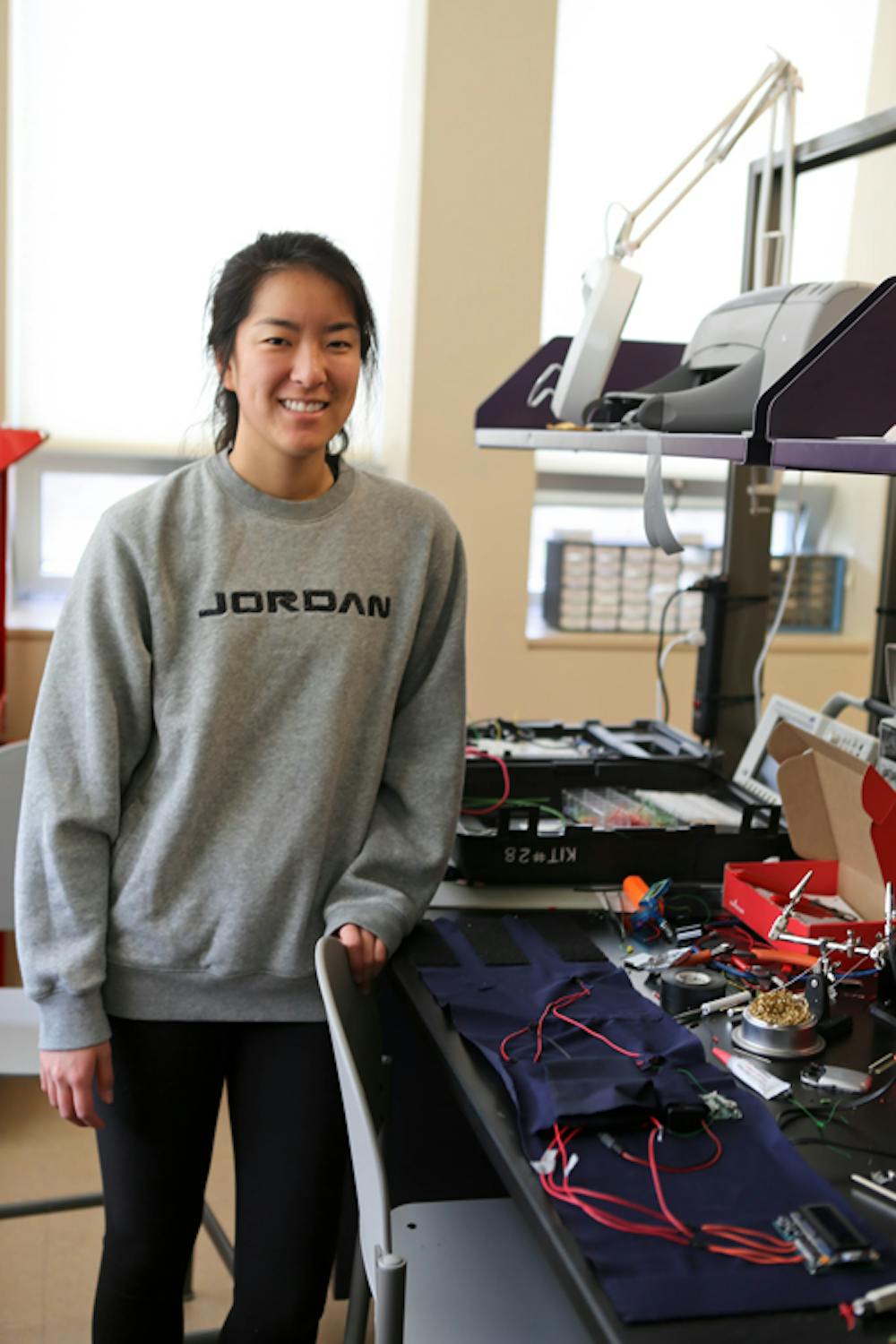(Becca Tabor | THE BEACON)
By Kate Stringer, Staff Writer stringer14@up.edu
UP's School of Engineering requires all graduating senior engineers to complete a yearlong senior design project. Students within the engineering tracks of mechanical, electrical, computer science and civil work in teams to create and design projects in their discipline.
Electrical engineering - The Posture Pedometer Cummerbund
Team Members: Kelly Han, Kyle Mauer, Kevin Vo
Sitting at desks all summer got seniors Kelly Han, Kyle Mauer and Kevin Vo concerned about their posture.
"We were trying to think of something we could do, and we wanted it to be useful," Han said. "We realized that after a long eight-hour day we'd been sitting horribly and our backs would hurt, so it just seemed like a good idea."
This good idea turned out to be the Posture Pedometer Cummerbund, a device that aids both posture and physical activity. The Posture Pedometer Cummerbund consists of a fabric belt that is worn around the upper waist. When a person slouches, motors similar to ones in a phone vibrate to inform the wearer she is slouching.
Additionally, the device includes a pedometer to count the wearer's steps throughout the day.
While Han has worked on other projects during her time as an engineering student, she enjoyed the opportunity her senior design project gave to build something from scratch.
"It was our first experience designing something completely on our own and trying to figure out how to do it, working through all the problems that might come up," Han said.
To build their project, the team had to learn how to use an Arduino microcontroller, which is a small on-chip computer. The microcontroller uses its own programming language that the team hadn't experienced prior to building their project.
Han, Mauer and Vo will be presenting their Posture Pedometer Cummerbund on Founders Day.
Civil engineering - UP Recreation Center
Team Members: Brett Cates, Devon Sullivan, Moussa Gloyd, Trevor Webber, Zach Marsh, Caleb Patterson, Preston Longoni
While UP makes plans for its new recreation center, a group of civil engineering students already has it built - in theory.
Brett Cates' senior design project is to create a theoretical recreational center for UP. Although UP has its own group of engineers working on designs for the rec center, Cates' group still met with James Lyons, vice president for university relations, to align their project with UP's vision for their new rec center.
The group designed everything from the structure of the building to where basketball courts and swimming pools would be placed.
Cates said that instead of picking their project, his team was assigned to design the UP rec center.
"We basically just got handed a pamphlet that had a really rough sketch of the floor plan of the building and were told to go with it," Cates said.
For a group of seven, finding a time for everyone to meet was the most challenging part. In the span of a week there is only a two hour section of time available for all the team members to meet.
Even though the group won't be building a tangible structure, they still used money from their budget to buy a license for Google Sketch-up, a 3-D modeling program to design buildings.
Cates enjoyed working on the designs of the rec center, especially being able to use computer programs at the Portland structural engineering firm Degenkolb to further design the project.
Cates, Sullivan, Gloyd, Webber, Marsh, Patterson and Longoni will have a poster on Founders Day on their designs for UP's rec center.
Mechanical engineering - Parkinson's Eating Tool
Team Members: Jordan Heintz, David Lee, Victor Torres, Juliana Flores, Melissa Ishii
Jordan Heintz may eventually have a patent on his senior design project.
Heintz's group is designing a specialized eating tool for people with Parkinson's disease. The eating utensil is designed to counterbalance the shaking hands of an individual with Parkinson's so eating is less of a battle.
Heintz hopes his group can eventually get the eating utensil out on the market and sell it as a nonprofit so that people with Parkinson's can benefit from their tool.
"Just to see [individuals with Parkinson's] and their excitement I guess would be the whole goal," Heintz said.
The Parkinson's eating tool has been a senior design project in the past. However, Heintz's team is working to improve several flaws in the tool, one being that the original design was too bulky.
"The thing about engineering is that you can always do better, it's just [a matter of] when you want to stop," Heintz said.
To improve the design, the team had people with Parkinson's disease test their utensil and give feedback.
Heintz found that transforming work and design into a physical product was the most satisfying.
"It's one thing to see all the calculations on paper or to model it on the computer, but to have the physical thing in someone else's hands [was the most exciting part]" Heintz said.
Each engineering group receives $300 from the dean of the school of engineering, according to Heintz. However, the group used about $1,000 of their industrial adviser's 3-D print money to produce prototypes of the utensil. Heitz said groups that need more money can go to the dean with requests.
Heintz, Lee, Torres, Flores and Ishii will present their Parkinson's Eating Tool on Founders Day.
Mechanical engineering seniors David Lee, Jordan Heintz, Melissa Ishii, Victor Torres and Juliana Flores pose with their mechanical hand testing apparatus for their senior design project. (Becca Tabor | THE BEACON)
Senior Kelly Han with her engineering project, the Posture Pedometer Cummerbund. Once the project is complete, it will help improve a person’s posture. (Becca Tabor | THE BEACON)
The civil engineering group designed a recreation center for UP. Their project is theoretical, but their designs are similar to those of UP’s to-be rec center. (Becca Tabor | THE BEACON)
(Becca Tabor | THE BEACON)








